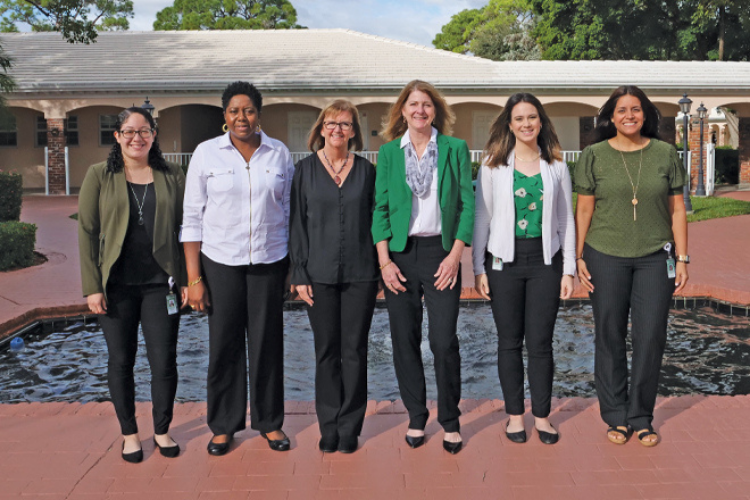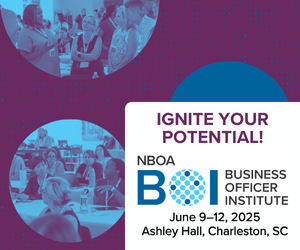Nancy Greene is vice president for finance and operations/CFO at Pine Crest School, a preschool–grade 12 school with 2,688 students on two campuses, one in Fort Lauderdale and the other in Boca Raton, Florida. She is the 2022 recipient of the Ken White Distinguished Business Officer Award.
Net Assets: One reason you received the Ken White Distinguished Business Officer Award is that you have given dozens of presentations over the years that have helped business officers not only in Florida but around the country better understand risk management, financial management and other essential topics. You told me of all the presentations you do, you most enjoy those on school finances to school staff and faculty. Why is that?
Nancy Greene: I've been presenting finances to faculty and staff at every school I’ve worked at [three schools over the course of 27 years]. Years ago it was new, not many were doing it. Today it’s even more important because there are continuous pressures on the business model, and there's much more need for everybody to understand it. A lot of schools now have implemented a “state of the school” presentation, which I do, in addition to teaching the basics of how the finances work.
Today it’s even more important because there are continuous pressures on the business model, and there's much more need for everybody to understand it.
I recently presented on our latest tuition increase to faculty panels on both of our campuses and explained the conditions we are facing, how it's all an algebraic equation and a zero-sum game, how we have to make some tough choices about the balance between setting tuition and other cost increases — supply chain demand, labor shortages, significant raises. It was really helpful for faculty to understand all that goes into the decisions.
I like to use the analogy of their home. When you run your family and your home, it's complex. You've got all these puzzle pieces that have to fit in and balance. Utilities are going up, for example, and it's costing you 10% more than you budgeted. I think that they were able to understand that the school is faced with the same things they're faced with, and on top of that, the school is trying to ease what they're faced with financially, so it’s a double impact for the school.
Net Assets: And how have faculty and staff reacted to this more in-depth financial information, given recent changes in the market landscape?
Greene: I think they really understood it. We got a lot of positive feedback. It’s the first in a series I’m doing with our executive director of educational design and strategic initiatives and our vice president of academics. The next one will be a deeper dive into compensation packages, making faculty members aware of all the pieces invested their package, how we offer more than just a salary. After that we will present on the campus semester plan and the next wave of developing our new strategic plan. For the series, we’ve set up a “Pine Crest Faculty Panel,” a group of teachers who will spread the message about these sessions and help answer questions for other faculty. They’re like ambassadors.
A few years ago, it seemed we’d have to shoulder difficulties for a finite period. Now we know that some expenses are not going to go away, which requires total recalibration and the ability to be nimble. The more faculty and staff know and understand that's the environment we're in and the things we're facing, the better off morale and commitment will be, and the better off the institution.
Net Assets: You’ve given presentations at the national level on the composite financial index (CFI), a set of ratios that communicates succinctly the financial health of your school over time. It’s generally used not for staff and faculty but for driving strategic board and other senior leadership discussions. The CFI may seem a bit complex to some — how have you made use of it?
Greene: There are so many metrics that we can use to measure performance, but many of them look unilaterally at one thing, and obviously so many things contribute to a school being financially sustainable. Metrics alone will only tell a little piece of the story. I love the CFI because it's integrated. It’s a mechanism to tell a story about several key financial levers. And so that's why we've studied it, and my board has embraced it.
I do a CFI training with the board of trustees. In order for the CFI to be powerful, you need to ensure that your board of trustees understands the metrics and that you present it in all of your forward-thinking projections. In addition, you should establish a goal with your board, for example, to stay within a certain CFI range to ensure the long-term health of the school.
We all understand there are nuances to it. The scores can vary any given year, which is why I run averages [instead of focusing on the CFI for one year alone]. A lot of positive things can happen in one year, especially if you're fundraising — the finances can look really strong, and then the next year, when you spend the money for buildings, for example, you don't look as strong. But when using CFI averages, it’s a really good tool to keep us on track.
When I do the 10-year strategic plan, I budget out how the different assumptions we're making will impact our CFI scores. I would recommend building the CFI calculation into your long-range model so that school leaders can see how key decisions will impact finances. This helps the board establish guardrails within which to stay when making decisions. We even graph each of the CFI components and the overall score in relation to the school’s history and the forward-looking long-range plan.
Net Assets: So it sounds like one key to using the CFI well is having an initial board meeting to establish understanding, and then to keep returning to it over time.
Greene: Yes, and that’s true with other things too. For example, every year we have two meetings about tuition. We first address it in our October board meeting, when I remind the board that our decisions need to be strategic and long-viewed, not emotional. If there’s just one tuition meeting, there's a lot of emotion. So I use the October meeting to go over the CFI and our agreed upon financial guardrails that we have said we won't violate. If we violate them, we’ll violate the long-term position of the school.
And because boards turn over, I give them articles on what's happening out in the market, and on the CFI and tuition setting practices generally. We go over all of the themes of the articles that they have to read. And so the first meeting is all education and initial conversation and showing the long range model under different assumptions. I find they're really invested in this now. It's not just showing up to a meeting. They're really into it.
And then at the second meeting, four to six weeks later, we come back with any new things that have happened since that point in time; change is happening so quickly. The administration then makes its recommendation. We have a very efficient and much less emotional meeting than we had in the past. It's very data-driven. I mean, I'm not going to say there's no emotion in it. Most board members are parents, and they're thinking about themselves a little; they're thinking about their peers and friends and maybe what's going on in their personal life, which may not be the same as others’ lives. You're never going remove all of that, but two meetings help.
Net Assets: Another strategy you’ve been able to implement at different schools is enterprise risk management (ERM). Do you have any tips for tackling what may seem like an immense project?
Greene: It has been easier at some schools than others. At The Bolles School in Jacksonville, we had an attorney on our board who was a risk manager for a very large high-risk entity. She was highly driven to mitigate school risk as much as possible in a reasonable way. And she was the audit committee chair, so we did ERM through the audit committee.
The first time I did ERM, it was such an overwhelming topic that it seemed impossible to wrap my mind around, so I just started brainstorming risks and putting them into risk categories. Then with my team, we added to the list, refined categories and prioritized high-impact risks that were most likely to occur. Whatever mitigation strategies were not already in place we began to put in place, one step at a time.
We actually had a risk management document with all this information: risks, risk categories, likelihood, impact and mitigation. It was worked through our attorney, so it couldn't be shared with outside people who might say, these are the only risk things they do? Some schools are concerned to put it in writing for that very reason, which is why we chose to work it through our attorney.
Include others, invite them in, let them own the process with you. You will be better for it, and the outcome will be far better.
My advice to other business officers is to break it down into small pieces and create a structure and framework to attack it. Once you have the framework outlined, you can identify the teammates you need to complete the process. Include others, invite them in, let them own the process with you. You will be better for it, and the outcome will be far better.
Net Assets: You’ve ridden out hurricanes at your schools. Can you share any stories about those times?
Greene: My favorite memories from the very serious hurricanes I have experienced relate to how the community came together. After Hurricane Matthew, when I was at Bolles, we emailed everyone saying that we needed help cleaning up our campuses, and students, parents, teachers and administrators all showed up and were out there picking up the mess, raking, cutting branches and pushing water out of buildings. People brought food to share, and we opened up the grills on the lawn. That was community at its best, and we are so lucky to have this alive in our schools. We were ready to open back up after just that one cleanup day, but we couldn't because we did not have power! Fortunately, we have not had any major hurricanes in the last several years.
Net Assets: You mentioned risk management approaches have been different at each school you’ve served. What has been key to learning the culture and organizational mores at each of those three schools and succeeding within them?
Greene: I’ve loved all the schools I’ve worked at, and they’ve all been different.
The key to learning culture is to be a good observer. Do a lot of listening and learning. You will probably hit some bumps along the way. You'll learn by stepping on the landmine; that’s just part of how it works, but you can also be ready to adjust. And you really need to build relationships, get out of your office. It’s important to network on a national level but also within your organization too. You need to understand how the whole school is operating and, and what makes it tick, and really understand the strategic plan because the business officer plays a key role in bringing the strategic and campus master plans to life.
At Pine Crest, for example, I am out and about on the campus. I go to each division and walk the campus rooms with the division head. We talk about programmatic needs and what they have on the slate. In addition, I have fostered a great relationship with the vice president of academics and the executive director of educational design and strategic initiatives. They hadn’t seen the CFO much on campus before. It is a big campus, so it’s easy to miss someone; you can't just walk around once. You need to become part of the community, interact, go to some games, even if your kids aren't in them. Personally, I like to go to volleyball games. Participate in things when you can, just for fun, like Senior Donut Day — be out there on the deck with the seniors. Know what's going on in your community and get out and be a part of it.






